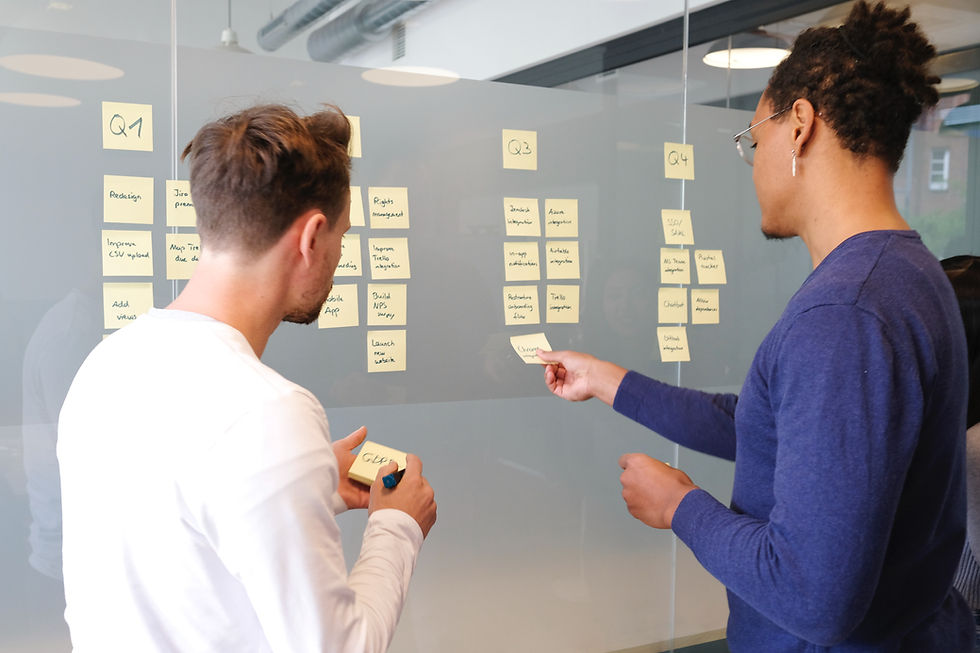Introduction to Story Mapping and Feature Mapping
- Joel Oosthuizen

- Feb 24, 2017
- 3 min read
Updated: Feb 29, 2024

Introduction
In Agile software development, story mapping and feature mapping are techniques used to explore requirements. They are visual tools that help teams organize and prioritize product features or user stories. Both techniques are used to create a shared understanding of the product, its goals, and its users.
Origin of Story Mapping
Story mapping was created by Jeff Patton, a product design and development consultant. He developed the technique in 2005 as a way to visualize user stories and product requirements. Since then, it has become a popular technique in Agile software development.
What is the Purpose of a Story Map?
The purpose of a story map is to provide a helicopter view of a product or project. It is a way to visualize the user's journey through the product, from the initial touchpoint to the final goal. Story maps help teams prioritize and organize product features and user stories, ensuring that the most important features are developed first.
Benefits of Story Mapping for the Team, Product Owner, and Organisation
Story mapping provides several benefits to the team, product owner, and organization, including:
1. Better Communication: Story maps help teams communicate requirements and priorities more effectively, ensuring that everyone is on the same page.
2. Prioritization: Story maps help teams prioritize product features, ensuring that the most important features are developed first.
3. Clarity: Story maps help to clarify the product's goals and user's needs, ensuring that the team is building the right product.
4. Incremental Development: Story maps help teams plan and execute incremental development, ensuring that the product is delivered in small, usable increments.
5. Visualization: Story maps provide a visual representation of the product, helping teams to see the big picture and make more informed decisions.
The Structure of Story Mapping
Story maps typically have two main components: the backbone and the stories. The backbone represents the user's journey through the product, while the stories represent the product features and user stories that support that journey.
The backbone is usually created using sticky notes or index cards and represents the key stages in the user's journey. For example, the backbone might include stages such as "Sign up," "Select a Plan," "Add Payment Details," and "Use the Product."
The stories are added to the backbone as sub-stages and represent the product features and user stories that support each stage. For example, under the "Sign up" stage, there might be stories such as "Enter Email Address," "Enter Password," and "Confirm Password."
When to Use a Story Map
Story maps are useful at the beginning of a project when teams are trying to understand the product's requirements and prioritize features. They are also useful throughout the development process to ensure that the team is building the right product and that features are being developed in the correct order.
Stakeholders to Story Mapping
Story mapping is a collaborative technique that involves multiple stakeholders, including the product owner, development team, stakeholders, end-users, subject matter experts, architects, and so on. By involving all stakeholders in the story mapping process, the team can ensure that everyone has a shared understanding of the product's goals and priorities.
Tips to Get Started with This Practice
1. Start with the Backbone: Begin by creating the backbone of the story map, representing the key stages in the user's journey.
2. Identify Stories: Identify the product features and user stories that support each stage of the backbone.
3. Prioritize Stories: Prioritize the stories based on their importance to the product and the user's journey.
4. Revisit the Map: Revisit the story map regularly to ensure that it remains up to date and reflects the team's current understanding of the product.
5. Collaborate: Involve all stakeholders in the story mapping process, ensuring that everyone has a shared understanding of the product's requirements and priorities.
Conclusion
In conclusion, story mapping and feature mapping are valuable techniques for Agile teams to explore requirements and prioritize features. They provide a shared understanding of the product and its goals and help teams build the right product in the right order. The benefits of story mapping include better communication, clarity, prioritization, incremental development, and visualization. When using story mapping, it's important to involve all stakeholders, including the product owner, development team, stakeholders, and end-users. By following the tips outlined above, teams can get started with this practice and begin reaping the benefits of story mapping in their Agile development process.





